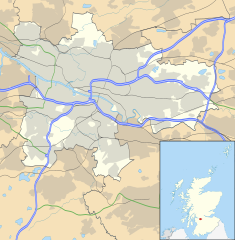|
Govan Town Hall
Govan Town Hall is a former municipal facility on Govan Road, Govan, Scotland. The town hall, which was the headquarters of Govan Burgh Council, is a Category B listed building.[1] HistoryThe building was commissioned to replace the Govan Municipal Buildings in Orkney Street which were completed in 1867.[2][3] After rapid industrial expansion and population growth in the local area,[4] civic leaders found this arrangement was inadequate and they decided to procure a purpose-built town hall: the site they selected was open land at the corner of Summertown Road and Govan Road.[5] The foundation stone for the new building was laid in September 1898.[6] It was designed by Thomson & Sandilands in the Beaux-Arts style, built at a cost of £60,000 and officially opened by the Provost of Govan, James Kirkwood, in October 1901.[7] The design involved a symmetrical frontage with thirteen bays along Govan Road with the end bays projecting forward; the central section of three bays featured an arched doorway on the ground floor; there were three windows behind a tetrastyle Ionic order portico on the first floor and a large pediment containing a carved tympanum above. At roof level there was a large dome with a colonnaded cupola on top.[1] There were several portrait busts, designed by Archibald Macfarlane Shannan, placed on the Govan Road elevation of the building.[8] Internally, the principal rooms were a council chamber in the eastern section of the building, together with a large public hall with a grand organ and a smaller "upper hall", both in the western section.[9][10] The grand organ was designed and manufactured by Norman and Beard and had four manuals.[11] The town hall was the headquarters of Govan Burgh Council until Glasgow annexed Govan, after a series of anti-amalgamation demonstrations, in 1912.[12][13] The building was subsequently used by the social services department of Glasgow Corporation: the ornate decoration in the two halls in the western section, including a magnificent proscenium arch inside the public hall, which had also been designed by Shannon, was completely destroyed during a refurbishment of the building in 1973.[1] In the early 2000s, Gillian Berrie, a film producer, secured access to the building and raised £3.5 million to convert it into a film production facility known as Film City Glasgow.[14] The works involved refurbishment of the upper hall, installation of a Dolby theatre and upgrading the eastern section (i.e. front) of the building for use by creative media businesses.[14] See alsoReferences
|
||||||||||||||||||||||||
Portal di Ensiklopedia Dunia

